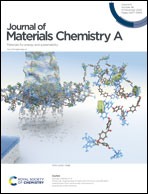Boosting hydrogen and oxygen evolution reactions on electrodeposited nickel electrodes via simultaneous mesoporosity, magnetohydrodynamics and high gradient magnetic force†
Abstract
Here we report on hydrogen and oxygen evolution on electrodeposited nickel electrodes enhanced by mesoporosity and magnetics. Mesoporous and bulk Ni films were electrodeposited from simple sulphate solutions with and without lyotropic liquid crystal (LLC) templates formed by the cationic surfactant cetyltrimethylammonium bromide (CTAB). The mesoporous microstructure increases the electrochemical surface area 20-fold relative to the bulk films. In the first instance, this improves the hydrogen (HER) and oxygen (OER) evolution reaction performances significantly on mesoporous (MP) Ni electrodes, but only to a limited degree owing to the substantial surface deactivation of nickel and surface coverage during water splitting in alkaline media. The water splitting process is further enhanced by magnetisation on both bulk and mesoporous Ni electrodes, as evidenced by the reduced onset potential, over-potential, and Tafel slope, as well as by the increased exchange current density; these effects are stronger in the perpendicular magnetisation direction owing to the ordinary magnetohydrodynamics (MHD) effect. However, MP-Ni electrodes exhibit extraordinary performance with respect to ordinary MHD, which was attributed to the creation of high-gradient magnetic force (HGMF). The maximum HER performance of the magnetised MP-Ni electrodes demonstrates a remarkable improvement, e.g. ηOER = 340.0 mV, which is comparable with more complex nanomaterials, e.g. hybrid metal oxides, whereas their maximum OER performance, e.g. ηOER = 296.0 mV, comes very close to those of noble metal electrodes, e.g. Ru2O. Our calculations based on a simple nanotubular nickel structure show that MP-Ni creates magnetic gradients of the order of 107 T m−1. This magnitude of magnetic force is sufficient to promote effective attractive/repulsive forces on ions and gas bubbles as well as the dissociation of diamagnetic water molecules, enhancing the HER and OER during water splitting during electrolysis. Our present remarkably enhanced water electrolysis device, achieved using magnetized mesoporous nickel, represents a very sophisticated and low-cost electrode material choice to replace costly electrocatalysts in water splitting.



 Please wait while we load your content...
Please wait while we load your content...